#BUCPUA Professor reveals how to land the best job ever

On September 29, more than 250 policymakers and job seekers gathered at the 8th Annual Massachusetts Green Careers Conference, held at the DCU Center in Worcester. BU City Planning and Urban Affairs (BUCPUA) Adjunct Faculty Professor Eugene Benson, JD addressed the entire crowd and also led a smaller breakout session. Benson compelled the audience to pursue the best job ever – municipal conservation agent.
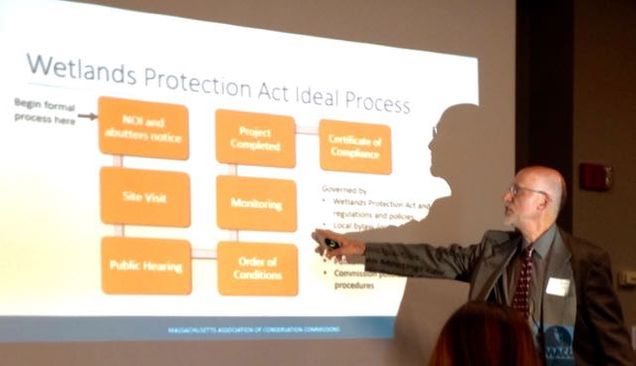
Passionate degree candidates in the #BUCPUA Program assess the social contexts and economic structures that influence the management of fragile open spaces, such as wetlands. The #BUCPUA Program provides students with high-demand tools and pertinent skills to excel as environmental planners. Relevant course offerings include UA 521 Environmental Law, UA 617 Applied Sustainability, UA 654 Geographic Information Systems for Planners, and UA 629 Urbanization and the Environment. Students can complement their Master of City Planning or Master of Urban Affairs degree with a Certificate of Applied Sustainability.
Aside from teaching law to #BUCPUA students, Benson is the Executive Director of the Massachusetts Association of Conversation Commissions (MACC). MACC’s tenants include advocacy, education, and conservation, and the state leader in providing education and training to more than 2,500 conservation commissioners. Benson urged participants to fully grasp the wetlands crisis in the United States, as half the country’s wetlands have disappeared since settlement by Europeans. This loss of wetlands has exacerbated flood conditions, particularly in states like Iowa, which has lost 80 percent of its wetlands. Wetlands perform invaluable functions by buffering floodwaters, capturing carbon, and providing habitats that sustain biodiversity.
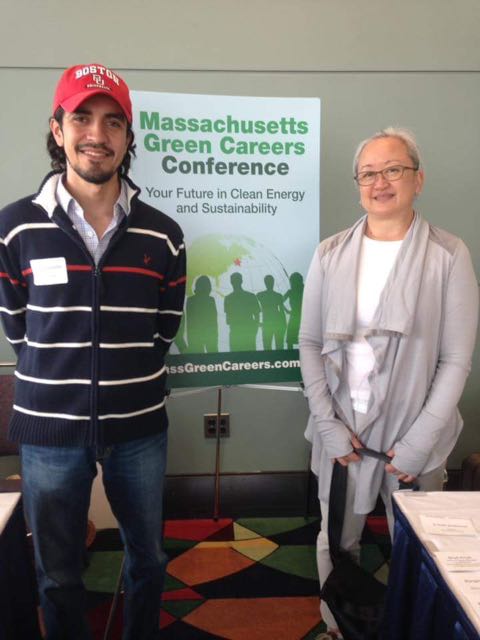
As municipal conservation agents, citizens have a direct stake over the protection and management of these vital, yet vulnerable, areas that envelop land, water, and biological resources. Conservation agents are full-time positions that support and guide all-volunteer municipal conservation commissions. On average, volunteer conservation commissions experience a 10 percent annual turnover, which underscores the value of a municipal conservation agent who can create a stable foundation for long-term planning and land management.
At the state level, the Massachusetts Department of Environmental Protection, the Massachusetts Department of Conservation and Recreation, and Massachusetts Regional Planning Agencies also offer full-time positions that directly influence the protection of open spaces. Qualifications required for state or municipal conservation agent positions include a thorough understanding of environmental law and superb communication skills that conform when influencing different stakeholder groups. Organization skills, creativity, and flexibility also help conservation agents preserve open spaces against myriad external factors, including impacts of climate change and ongoing economic development.
Aside from teaching law in the #BUCPUA Program, Professor Benson also instructs courses at the BU School of Public Health.

Education and Games Take Center Stage with #BUcityplanning at the Sustainability Festival

On Thursday, September 14th The City Planning and Urban Affairs Program participated in the 2017 Sustainability Festival at Marsh Plaza. #BUcityplanning students, alumni, and faculty joined 24 clubs, from Net Impact to the BU Outing Club, as well as leaders from the BU Environmental Leadership Network to educate the larger BU community on the importance of sustainability on topics such as climate change, recycling, transportation, and agriculture. Participants also had to the opportunity to play games, win prizes, enter in a challenge to reduce their environmental footprint, trade in old light bulbs for LED bulbs, register bikes for Bike & Pedestrian Safety, and get a free “Ride Ready” safety check by local bike mechanics.
“Sustainability is a very important topic in the City Planning and Urban Affairs Program,” said Dr. Yesim Sungu-Eryilmaz, Assistant Professor. “Many of the classes in our program touch on sustainability, and we also offer a Graduate Certificate in Applied Sustainability.” It’s important for us to be a part of the conversation and educate the community on sustainability.
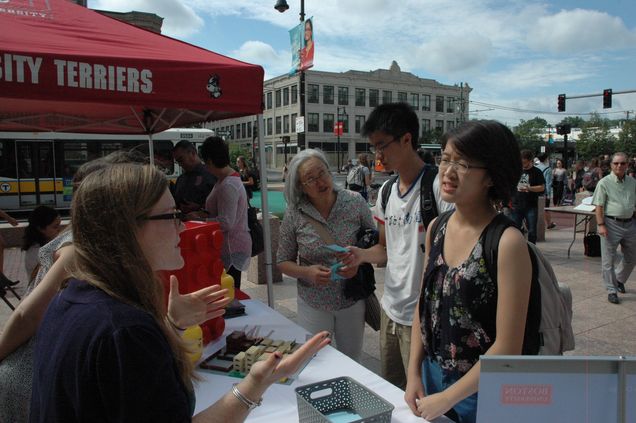
“We came up with idea to play a True or False game,” said Dr. Sungu-Eryilmaz. We wanted to do something that was interactive and immersive, as well as fun, quick, and educational, but not too difficult because everyone has a different knowledge base when it comes to sustainability, and we wanted the prizes to relate to theme as well.” Overseen by Dr. Sungu-Eryilmaz, three students, Patricia Cahill, MCP ’18, Fiona Coughlan, MCP ’18, and Diego Lomelli, MCP ‘18 and one alumna, Monique Yaptenco, MUA ’17 came up with fifteen True or False questions on topics relating to climate, food deserts, transportation, urbanization, and recycling. Each contestant had to answer two True or False questions. Even if the contestant got both answers wrong, everyone still won a prize. The goal was to help educate individuals on sustainability and to expose them to issues they might not be aware of.
The prizes were donated from Stride Incorporated, an environmentally friendly office supply company that is committed to making products and changes within their company that is beneficial to the environment.
Being a part of the Sustainability Festival gives #BUcityplanning a chance to get out and do something different, as well as a chance to share with the larger community issues and topics the Program is passionate about.

Article by Andrea Ciminelli
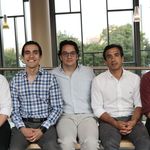
Boston University Students and Alumni Win IXL Innovation Olympics
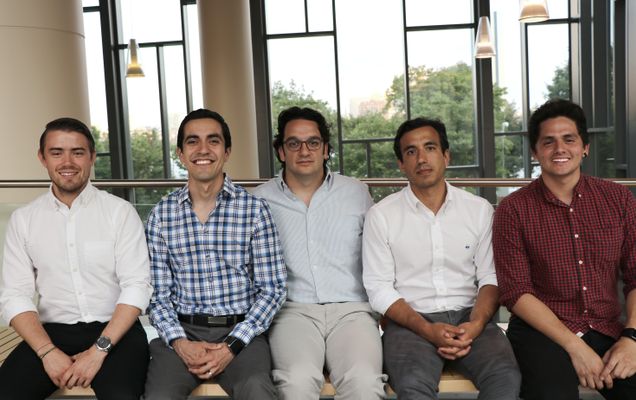
With participants from universities such as Harvard, New York University, Georgia Tech, Duke, and London School of Economics, the IXL Innovation Olympics is a prestigious 8 week global consulting competition. Graduate student teams are paired with professional coaches as mentors; sponsors then provide guidance to the teams during alignment sessions, and pick the winning business plans and team.
The winning team consisted of Boston University current students Ruben Ceron (MUA '18) and Diego Lomelli (MCP '18) and alumni Alejandro Delgado (MBA, MUA '17), Luis Quintanilla (MBA, MCP '17), and David Valecillos (MCP '14). The team’s proposal for the development of a business innovation district for the Government of Atlántico in Colombia consisted of three strategic goals, including aligning the innovation ecosystem, promoting the digital economy and e-Services to new and existing businesses, as well as boosting real estate development under a “smart growth” approach. For their hard work and efforts, the team will be rewarded with a $4,000 prize.
"Aligning the innovation ecosystem implies the creation of a legal entity in charge of matching the interests of key stakeholders, including the citizenry, business sectors, academia, and the public sector," explained Luis Quintanilla. "This entity would be formed by a board of trustees in charge of aligning stakeholders' interests and overseeing progress as a whole toward the vision of the innovation district, as well as by an executive management team responsible of administrating land use and real estate development, as well as implementing the e-Services provision strategy to spur business development." Quintanilla's contributions to the proposal included development of funding strategies for the construction of the innovation business center through land-based financing mechanisms and land value capture tools; elaboration of the action plan and timeline for the implementation of the e-Government and ERP platforms; summarization of public policy recommendations for new business development, businesses' capacity building, financing strategies, and land use regulation.
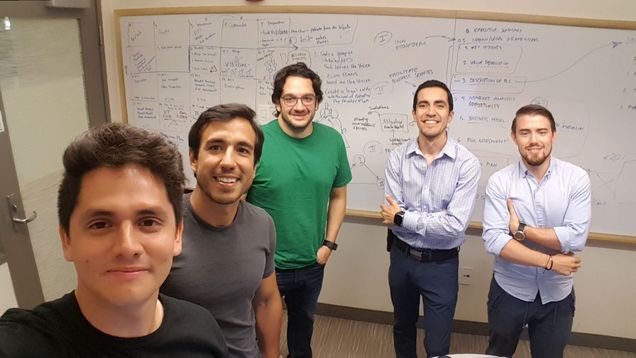
Furthermore, in order for Atlántico to transition to a digital economy, the BU team proposed two key concepts. The first is the creation of an e-Governance online portal to facilitate interaction between citizens, businesses, and government, which would enhance access to public and commercial services, online education, training programs, pools of talented workforce, and permits and licenses, among other benefits. The second concept is the launch of a regional digital platform consisting of cloud-based, shared services for small-medium enterprises (SME's) to help them build managerial and commercial capacities by means of an ICT-delivered Enterprise Resource Planning (ERP) program. "The ultimate objective of these two concepts is to increase productivity and entrepreneurship across all business sectors in Atlántico," said Diego Lomelli, who helped develop a business model to promote the digital economy and e-services for businesses to boost innovation, create new companies, transfer technology, develop capacity, promote worldwide networking, attract investment, and provide access to telecommunications, online ICT training, and smart infrastructure.
Finally, the BU team proposed the conceptualization of a physical urban space that promotes innovation and the exchange of ideas, which is made possible through the development of an innovation business center that integrates co-working office spaces and retail, as well as the headquarters of the legal entity and the executive management team implementing the innovation district's projects unfolding from all three strategic goals. The location of this innovation business center is proposed in the northeast region of the city of Barranquilla, right next to the Madgalena river, where important universities and multiple business centers are already clustered, and access to Transmetro (the city's bus rapid transit system) and main roads is handy. Sources of revenue for the construction of the innovation business center and further real estate development in surrounding areas include: fundraising and partnerships, freemiums obtained from the implementation of the e-Services platforms, private debt, and management of public land (sale of parcels, short and long term leases on land) and private land (tax increment financing, charges on additional development rights). Smart growth principles are also proposed as the overarching pathway to build the innovation business center, including: use of existing urban vacant land served by existing infrastructure, mixed-use development and mixed land uses, multi-modal transportation, pedestrian-friendly streets, compact and human-scaled urban design. David Valecillos' role was to define overall strategies to develop the innovation ecosystem in Atlántico, as well as identified means to generate revenue to finance the innovation district by managing public land and implementing land value capture tools. He also performed spatial analysis to identify clusters of innovation and possible district locations and designed the legal structure on which the innovation district can be built.
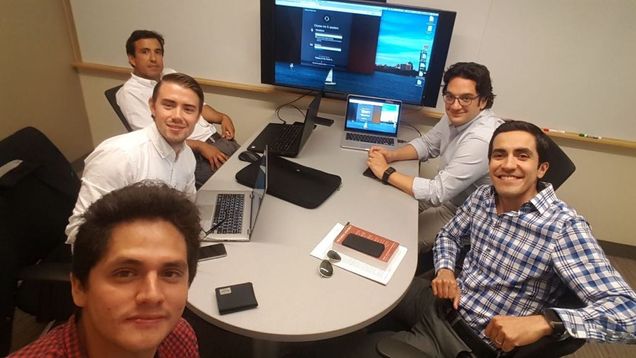
The team also elaborated on their experiences. According to Alejandro Delgado, “The methodology that IXL-Center shared with us is a great takeaway from this project. Also, working with local CEO's provided us with great insights about the conditions around Colombia and the State of Atlántico that helped us provide a viable solution. Also, the holistic knowledge and experience that our team has coming from different backgrounds, plus our skills in urban planning and economic development, provided us with and edge compared with the teams from other important schools.” The other members of the team expressed similar sentiments, citing the methodology used in the projects as an important takeaway from the competition.
The team is currently awaiting the information regarding the next steps in terms of rewards and implementing their proposal. So far, they have received an email from the IXL executive team announcing the winners, but dates and further information are not yet available.
Article by Meaghan T'ao, CAS '18
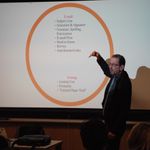
#BUcityplanning Professor Shares Best Practices for Effectively Communicating in a Competitive Job Market

On the 13th of November, the City Planning and Urban Affairs Program hosted a Professional Communication and Career Workshop from 6 to 8pm in the CAS building. #BUcityplanning adjunct professor Dr. William Koehler addressed a packed room on the tools and best practices for clearly and effectively communicating in the highly competitive job market. In this workshop, Dr. Koehler covered the key concepts, interaction types, essential principles, and goals of professional communications, as well as giving tips on writing professional emails and producing resumes and cover letters.
The students were asked to list the goals of professional communication, and suggested the following: to communicate and receive knowledge, deliver information, establish rapport with other people based on shared interests and goals, to control self-presentation; to create a personal brand, and to come to an understanding of wants and needs. Dr. Koehler stressed that when you introduce yourself, you choose what you want to reveal, and that in turns shows what traits and aspects of yourself you value. A few key concepts also discussed were the "Four C's" - clarity, conciseness, correctness, and cogency were all valued in communication; that is to say, communication should be clear and focused on the topic, have good grammar and spelling, and be easy to follow. Dr. Koehler also mentioned the quote "If you can say the same thing using fewer words, do so" as a good rule of thumb in terms of communication.
The group briefly discussed the different types of interaction and potential positives and negatives of each. For face-to-face or group presentations, more preparation might be needed but it would be

easier to communicate your point. For phone and Skype calls, the difficulty lies in the ability to see the other person's facial expression and to take visual cues from that in that manner. Next, the group moved onto the goals and objectives of professional communications and touched on professional etiquette. When in a professional situation such as interviews or a workplace setting, titles and formal address should be used, especially in written communication such as emails. The importance of politeness also cannot be understated; a simple "please and thank you" can show someone that you value their time and respect them, and set you apart from others. In professional communication, reason should come before emotion. Additionally, leaving a paper trail, such as a business card or other means of connection are also very helpful in the followup process. These tips could apply to any range of professional activities, such as employment opportunities, collaboration, personal branding, as well as marketing and self-promotion.
Some essential principles that were mentioned included appearance, use of voice, eye contact, and the flow of conversation. In terms of appearance, Dr. Koehler suggested to always dress a half-step more professional than you think you need to be. Some tips he also gave included paying attention to pacing, tone and volume of the voice, as well as distributing your attention and eye contact around the room when presenting to or interacting with a group. Road mapping and refreshing would also help the other person focus and make conversation easier to follow.
In conclusion, Dr. Koehler summed up some tips for writing emails, resumes and cover letters. For emails, the subject line is important as an indicator of content; senders should always include a salutation and signature, as well as checking their grammar, spelling and punctuation. Emails should be as brief as possible, with a minimum amount of links and attachments.
For resumes, Dr. Koehler stated that a clear format, chronology, balance of space, and using active language were all important aspects in creating a document that would be easy to follow and catch the reviewer's attention. Active language includes action verbs such as "produce", "lead", "coordinate", "facilitate", and "direct" talks about what the applicant has already accomplished and suggest competence and drive going forward. According to Dr. Koehler, recruiters only take an average of 30 seconds to read through each resume, which is why clarity of layout is very important. Additionally, Dr. Koehler suggested that the GPA of the applicant should only be listed if it is good (a 3.0 or above), and honors as well as relevant coursework and projects should be listed.
Cover letters should be written in a block format, with around three to four paragraphs and two thirds of a page in length at a maximum. Organization of the letter should be as follows: introduction, content, and action close. In the letter, applicants should demonstrate their understanding of the position and firm; more specifically, what the job does and why it is suitable for the applicant, why the job and employer appeals to the applicant, and relating qualifications. The action close constitutes the applicant's written acknowledgement to follow up. This time frame for following up is around two weeks, and applicants were advised to vary their methods of following up, for example by phone and with email.
Article by Meaghan T'ao, CAS '18
Poster by Jiayu Zhou, CAS '19

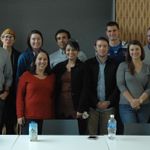
#BUcityplanning Students Increase their Marketability at Digital Design Skills and Portfolios for Planners Workshop
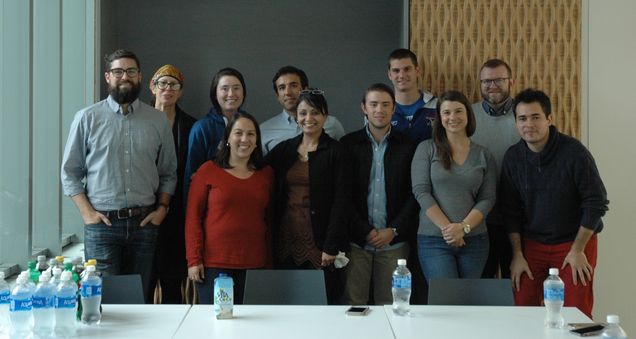
On October 14th from 10am to 2:30pm, in COM 206, the City Planning and Urban Affairs Program hosted a Digital Design Skills and Portfolios for Planners Workshop for #BUcityplanning students and Architectural Studies students. Brian Creamer started the morning with a session on digital design to help students acquire highly sought-after skills in the Adobe Create Suite. An MCP 2015 graduate, Mr. Creamer has a background in landscape and works at Nitsch Engineering for campus planning, and his current project is stormwater management for Princeton. Mr. Creamer also has a bachelors degree in landscape architecture from The Pennsylvania State University and a Master in City Planning from Boston University.
As the industry standard for design and planning, most designers use InDesign, PhotoShop, Illustrator, and Dreamweaver for custom website design. This software is useful because they have robust

tools. With major projects such as Tufts trying to digitize campus plans (and BU with a similar plan), Photoshop can be useful for building visualizations to help with community feedback. In conjunction with SketchUp 3D Warehouse, which is an Adobe plugin and provides stock buildings and objects such as trees and people, streets, sidewalks and buildings can be visualized in the software. Textures can be added and deleted, color can be adjusted and textures added with the software as well.
With Illustrator, users can import Shapefile for conceptual layout of roads and for building integration. To follow up with InDesign, everything should be bounded by a box, the template should have pages facing each other to read like a book in a column, and guides should be put on a layer and locked. All these steps can be reviewed online at Planetizen Courses.
#BUcityplanning courses, such as UA 613 Urban Design and Development, UA 654 GIS and Spatial Analysis, and UA 805 Urban Studies Capstone emphasize digital design skills and offer degree and non-degree seeking students an opportunity to enhance digital design skills and develop striking presentation materials.
Following this session, from 12pm to 1pm, students, faculty, and the presenters broke for lunch where they introduced themselves, detailing their backgrounds, interests, and future plans, as well as had an informal discussion on the importance developing digital design skills and having a strong portfolio to give future planners an edge in the competitive job market.
Following lunch, from noon to 2:30pm, David Valecillos held a Portfolios for Planners session. Mr. Valecillo studied Civil Engineering at the University of South Carolina and is in real estate development. While pursuing his Master in City Planning at BU, Mr. Valecillos worked as a research assistant at the BU Sustainable Neighborhood Lab, which is now a part of the Pardee Center. He is currently working on a redevelopment of 100 units in Salem.
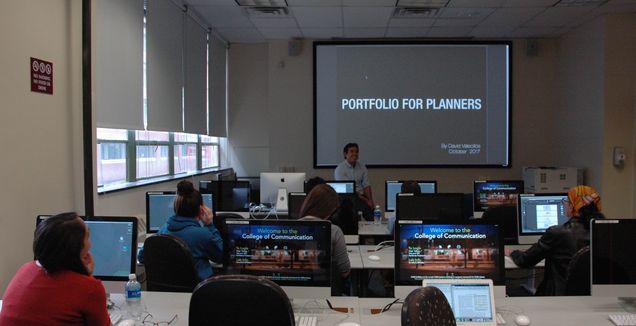
Mr. Valecillo explained the importance of a portfolio as a link between you and the employers, clients, or being considered for a grant. A portfolio should include past projects, practice areas, as well as values and mission. Additionally, work goals should be elaborated on, specifying for example interest in real estate, community planning, or policy.
Using Google Advanced Search, students can look up how competitors are building and presenting their research and use this as a frame of reference. Otherwise, key elements of a portfolio include not only the general content, but also the formatting and layout. Students were advised to choose around 3 to 5 colors (with dark blue, black and white as an example for a real estate or investment firm), as well as font styles such as Helvetica or Times New Roman. The hierarchy of the portfolio can be highlighted using color and indentations from the margin for emphasis. The paper size, orientation or flow of the portfolio, as well as the materials also play a certain part in the overall product.
Article by Meaghan T'ao, CAS '18
Poster by Jiayu Zhou, CAS '19
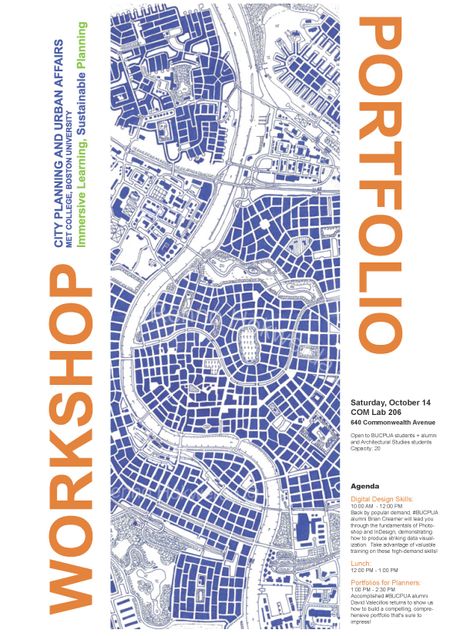

#BUcityplanning and Architectural Studies Host Two-Part SketchUp Workshop

On Wednesday 27th September and Wednesday October 4th, two workshops on the 3D Modeling software SketchUp were held. The Workshop was hosted by The City Planning and Urban Affairs Program and sponsored by the Architectural Studies Program. Michael Born, president and owner of Born Illustration Inc. presented and demonstrated the use of SketchUp for a variety of projects. With a Bachelors of Architecture degree from the University of Detroit Mercy, Mr. Born is also the founder of the monthly Boston Society of Architects SketchUp Bootcamp series, which aims to boost proficiency and is open to beginner and intermediate users of the software.
In his presentation before the demonstration, Mr. Born mentioned the importance of modeling things, citing famous architects such as Gehry and Gaudi and the methods they employed to model their projects. Models should be refined before digitizing, which is where SketchUp comes into play.
The advantages of using SketchUp are manifold. Mr. Born emphasized that “storytelling is the idea” and that the software was not
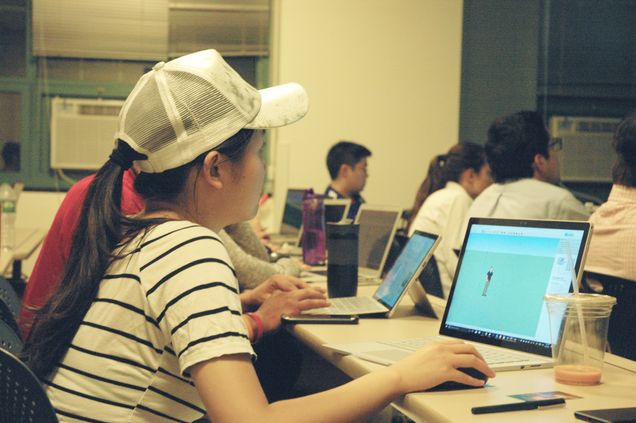
only useful to the user, but also to the client who wanted to view and understand the end product. With SketchUp, users can manipulate a lot of information all at once and use animation, different perspectives, and different angles to accurately visualize the finished product. For example, Mr. Born described how a remodeling project was presented to clients through the use of SketchUp’s animation feature, to help them understand how the current building would look once renovated. By taking the clients through the different steps of the renovation, the user would be able to convey his ideas by telling them a story.
In his demonstration, Mr. Born explained that using SketchUp was as easy as creating a face, and then pushing and pulling to manipulate the width or height. With these directions, the Workshop attendees were encouraged to play around with the software and try out different features. Mr. Born also showed the group how to select certain objects, and advised periodically grouping different objects to prevent stickiness and later complications. In the second session, Mr. Born also expanded on layering and organizing objects, for example, snapshots of google maps and bing maps layered over each other to create a guideline on SketchUp, as well as ghosting images of maps over the snapshots. Mr. Born also linked these ideas to real-life uses, drawing from a video about social life in small urban faces to bridge the gap between learning in class and real world locations and problems.
Article by Meaghan T'ao, CAS '18
Posters by Jiayu Zhou, CAS '19

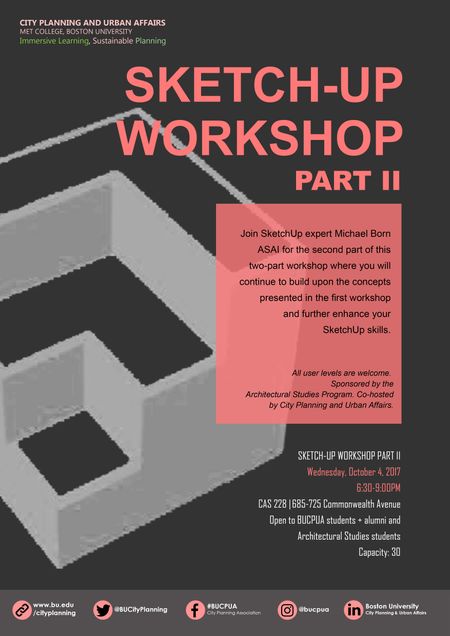

Urbanization in Ghana: Challenges and Opportunities
The Honorable US Ambassador of the Republic of Ghana visits BU to explore collaborations for urban expertise and development

@Initiative on Cities, Boston University, September 29, 2017
On Friday, September 29th 2017, the 19th Ambassador of the Republic of Ghana to the United States, Dr. Barfuor Adjei-Barwuah, gave a talk on sustainable development in Ghana. Having previously served as the Ambassador of Ghana to Japan, Dr. Barfuor Adjei-Barwuah presented his credentials to President Trump this past July.

In his talk, the Ambassador focused on the cities of Accra and Kumasi and the problems they faced in terms of sustainable development. Since the makeup, population, territory and facilities of a city change daily, the sustainable development of a city is hard to plan and carry out, especially in a way that is beneficial and of the least inconvenience to all the parties involved. This makes the definition of the word “sustainable” quite complicated; the shifting metrics of the city must all be considered and planned for. The City Planning and Urban Affairs Program at Boston University recognizes these challenges cities domestically and abroad are facing, and offers a curriculum based on similar issues in urbanization and sustainability in order for future planners to explore the fastest rate of urbanization, understand the issues and react to challenges.
One example the Ambassador gave was the sense of duty to keep the city presentable and picturesque in Kumansi. Apart from tending to and manicuring front lawns to keep them impeccable, residents were required to paint the roof every four years and the outside of the house every two years. While these requirements were relatively easy to meet, large-scale changes would not be met with the same amount of compliance and smoothness in carrying out the plan. Dr. Barfuor Adjei-Barwuah also mentioned that sometimes the government or city council responsible for urban development projects were required to be tough on residents and affected parties in order to transform the city effectively.
However, the question of property rights and individual freedoms is raised when large-scale city
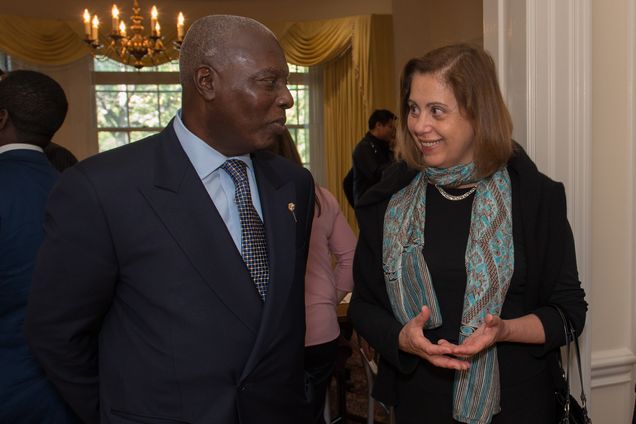
planning projects happen. While the urban space may benefit from such a change, residents may not agree with the changes and compromise the project. The city cannot afford to go to court over disagreements as the costs are high, may have to force residents to move.
Another possible difficulty Dr. Barfuor Adjei-Barwuah identified were the slums. Being well entrenched in the landscape, the cost of renewal in the area would be significantly high. Throughout, the Ambassador maintained that leadership in these projects were very important, and that key traits in a leader included a good conscience and having a well-developed plan on the ground that was ready to put into action. He concluded that as manufacturing and leisure is tied to economic well being, such urban renewal projects are often very important to a city.
After the talk, Dr. Barfuor Adjei-Barwuah attended a high-level meeting with representatives* from MET College and beyond, to discuss collaborations for urban expertise and development between Boston University and a Ghanaian University.
*The meeting was attended by Dr. Tanya Zlateva, Dean of Metropolitan College and Extended Education, Dr. Daniel LeClair, Professor and Chair of Applied Social Sciences, Katharine Lusk, Executive Director, Initiative on Cities, Neus Codina, Director, MET International, Dr. Madhu Dutta-Koehler, Associate Professor of the Practice and Program Director, Dr. Yesim Sungu, Assistant Professor and Director of the Urban Research Clinic, Kwabena Kyei-Aboagye, JD, Massachusetts Urban Environmental Program Manager and Adjunct Professor, Andrea Ciminelli, Program Manager, City Planning and Urban Affairs.
Article by Meaghan T’ao, CAS ‘18
Poster by Jiayu Zhou, CAS '19

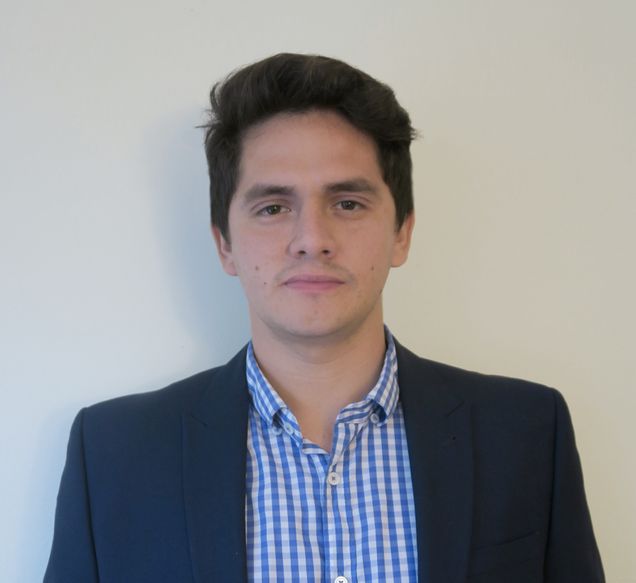
#cityplanningBU Student Proposes Strategic Plan of Urban Development for Valledupar, Colombia

The city of Valledupar, in the department (state) of Cesar, Colombia, has been suffering from an accelerated rate of growth. Valledupar was included among a group of 200 cities with the fastest growth in Latin America by the New York University Urban Expansion Program, United Nations Human Settlements Programme (UN Habitat) and the Lincoln Institute of Land Policy. Also, a large percent of Valledupar's population is low-income and a high percent of Valledupar’s high school graduates leave the City in order to find jobs and attend university’s in other cities in Colombia. Therefore, the City needs to make preparations for the coming expansion while it improves the quality of life for its inhabitants in order to keep residents living and working there. Valledupar's economy is predominantly based on agriculture and mining, and the City’s downtown is located by the Rio Guatapurí (Guatapurí River), an important natural resource in the area. The denser residential areas of the City live on the periphery, far from the downtown.

In 2015, a new Spatial Organization Plan (POT in Spanish) was apporved, which would strengthen and boost the expansion of Valledupar on its west side. However, the POT pushes the inhabitants on the City's periphery further out, creating greater social and economic disparities among residents. It also under utilizes greater environmental area along the Guatapurí River, which is located on the eastern boarder of Valledupar, by not creating an area of importance and promoting the growth of slums already located along the River. Ar. Rubén D. Cerón Guevara, MUA '18, approached the government to draw up a new proposal that would take advantage of the City's resources and its current condition to build a more sustainable city. With assistance from Dr. Madhu C. Dutta-Koehler, Director of the City Planning and Urban Affairs Program and Associate Professor of the Practice, Cerón and his team came up with an economic, social and environmental analysis of the City, which lead to an idea called Valledupar Sostenible. Vallepudar Sostenible is a 100-year vision for the City with the goal of integrating all the services and resources the City has in order to create a more sustainable, productive and efficient city. Within that vision, Valledupar Inteligente was developed, a 25-year proposal that addresses the current state of the City and works to move the City in direction envisioned by Valledupar Sostenible. Valledupar Inteligente's goal is to connect city services through technology, and the proposal analyzes and simulates how Valledupar would be if the area of expansion is developed on the east side of the City, and if the River becomes a vital area that structures mobility, environment, economics and zoning.
The proposal has three project phases. The first project will rezone and redevelop land along both sides of the Rio Guatapurí, which is predominantly slums and agriculture lands, and develop a green corridor with a
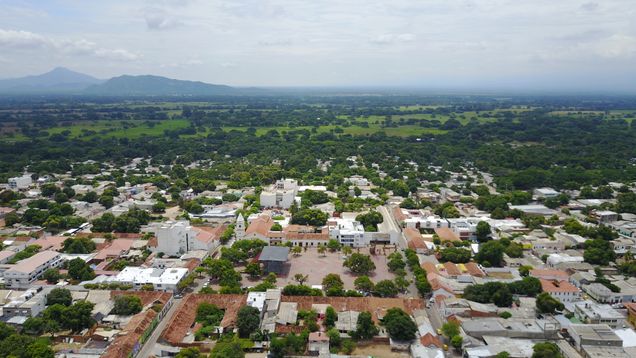
light rail system. The second project will expand the City on the east side of the River where a financial, governmental and administrative district will be developed. This will preserve a historical part of the City that is currently unable to expand. The expansion across the River will be developed in the concept of rings, similar to the model of the Garden City. The rings will continue to expand as they reach their capacity. This allows the population growth to be controlled. Also, since the light rail system will be running north and south along the River, there is a plan to reorganize SIVA so it travels along the rings and integrates into the rail system. The third project is the development of sustainable energy farms. The goal is to take the expansion land that has already been defined on the west side of the City and consolidate it for industry because they will be located closer to several industries already existing and other cities in the region. Currently, Valledupar does not have a reliable power service and this proposal requires a constant flow of power. There is also a need to contain the City, and the sustainable energy farms will act as a boundary to keep the City from continuing to expand westward.
Last semester, Cerón and his team performed a diagnostics of the City's conditions and what could be done to solve its current issues. This semester, the proposal is being shaped in preparation to be presented to governmental entities of Valledupar. This project is also being used as a case study in the MET UA 515 History, Theory and Planning Practice Fall 2017 course as a strategy to involve different perspectives on the project.
By Ar. Rubén D. Cerón Guevara, MUA '18, and Andrea Ciminelli
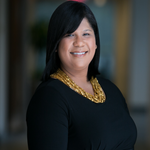
Beyond the Classroom
New #cityplanningBU Adjunct Professor Lourdes Germán, JD, Answers Nine Questions

1. Tell us a little about yourself?
In addition to my role on the faculty at Boston University, I serve as Director of International & Institute-Wide Initiatives at the Lincoln Institute of Land Policy and as Director of the Civic Innovation Project. At the Lincoln Institute, I advance our global municipal fiscal health campaign and our emerging campaign focused on Land Value Capture. This work is part of our mission as a foundation to seek to improve quality of life through the effective use, taxation, and stewardship of land. The Civic Innovation Project is an online thought leadership platform that uses technology to advance city-to-city learning with respect to the most challenging issues facing governments. I’ve been fortunate to partner with great organizations, like the Microsoft corporation, and others to run programs that convene public sector leaders in discussions related to the innovation eco-system across a range of issue areas that are part of the Civic Innovation Project. Prior to these roles, I spent a long career in public finance that included work as an attorney at a large international law firm, work as Vice President of municipal finance at a global investment bank, and work as the Chief Legal Officer and Vice President of Research of a municipal securities asset management company, and also taught government finance at a University. Outside of work, I enjoy volunteering on boards that help me stay involved in issues related to my field. For example, I serve as Governor Charlie Baker’s appointed Chair of the Massachusetts State Finance and Governance Board, among others.
2. What are your professional interests and why are you so passionate this topic?
My entire professional career, and work as a scholar, has been focused on government public finance, specifically examining the laws, policies, approaches, and frameworks that shape intergovernmental fiscal systems at the local, state, provincial, and federal levels in the US and abroad. A consistent theme in my current and future legal scholarship is the generation of original data regarding the fiscal conditions of governments, and an analysis of laws that facilitate the establishment of a municipal framework of fiscal governance that allow cities to use the widest range of innovations and tools to address their most pressing challenges. I’m passionate about this work because I care about the state of our cities and want to contribute to the creation of communities that are more successful, sustainable, and provide a good quality of life for their citizens. I also recognize that city leaders cannot do it alone and I want to be a part of the eco-system of stakeholders who can help leaders learn and apply the best strategies for their communities. This lead me to serve as one of the co-authors of the book, “Finance for City Leaders Handbook” published by the United Nations in 2016, for example.
3. What is the most challenging aspect of your work?
The most challenging part of teaching is what my colleague who is an instructional designer calls “productive struggles”- creating learning experiences that are not so easy that learners get bored and not so difficult that learners give up. I address this by trying to make the class as interactive as possible, this includes having students engage in a semester long exercise where they advise the Mayor of a city on a range of infrastructure decisions.
4. What brought you to the City Planning and Urban Affairs Program at Boston University?
My path to Boston University began with Dr. Madhu C. Dutta-Koehler, Associate Professor and Director of the City Planning and Urban Affairs Program at Boston University. In conversations with her to explore possible synergies between our organizations, I learned about her desire to expand curricular offerings in ways that introduce public finance to planners, among other concepts. When we discussed the potential for a new course that would teach students who are planning the future of cities about the financial decision-making that supports and enables urban plans, I was privileged to be invited to develop and teach the course.
5. What are you most excited about this semester?
My students. I’m excited to get to know them and understand their professional aspirations. The students at Boston University come from such incredibly diverse backgrounds and geographies – the contributions they make in the classroom always push the lessons and conversations in new directions.
6. What do you hope students take away from your class?
This semester my course focuses on one of the most significant challenges facing cities in the developed and developing world - meeting the global infrastructure gap. Leading research from organizations like the United Nations are estimating that cities have to invest $2.5 trillion annually in the coming decade just to keep pace with the demands of sustainable urbanization that is expected, with rising populations, across a range of sectors that are critical to citizens and their quality of life: transportation, power, water, telecommunications, among others. Students in my class will walk away with a clear sense of the prevailing avenues municipalities can use to address this and the decision-making process public officials go through when making strategic choices to finance this gap, as they plan for the future of their cities.
7. What do you like most about mentoring students?
I really enjoy mentoring and developing students and other young professionals in every setting I have worked. It’s incredibly gratifying to see a student progress in their knowledge and expertise on issues in the classroom, and to be a part of helping them create an important intellectual foundation in their journey as a scholar. The moments I most look forward to is seeing what my students go on to do after they leave the university and begin working in their chosen profession.
8. What is the most helpful advice you have received?
The most helpful advice I’ve ever received came from my greatest role model – my mother. Several years ago I was working for a wonderful organization in the private sector, but felt that I wasn’t challenging myself intellectually or learning new things in the day-to-day of my role. When I shared this concern with my mother she immediately said – “why don’t you teach? Teach what you know”. That advice really inspired me to think deeply and differently about my expertise, and forced me to reexamine how I could make the highest and best contribution with my work by sharing what I learned with others. That very year I developed my first course focused on government public finance and began teaching it in the graduate program of a university in Boston. It was one of the most professionally fulfilling experiences I have ever had. I discovered a passion for education and had a new understanding of my vocation that has guided the way I think about my career from that moment forward.
9. How do you like to spend your free time?
I am a lover of the arts. In my spare time you can find me quietly collaging, painting, or drawing for hours on end!
By Lourdes Germán, JD, and Andrea Ciminelli
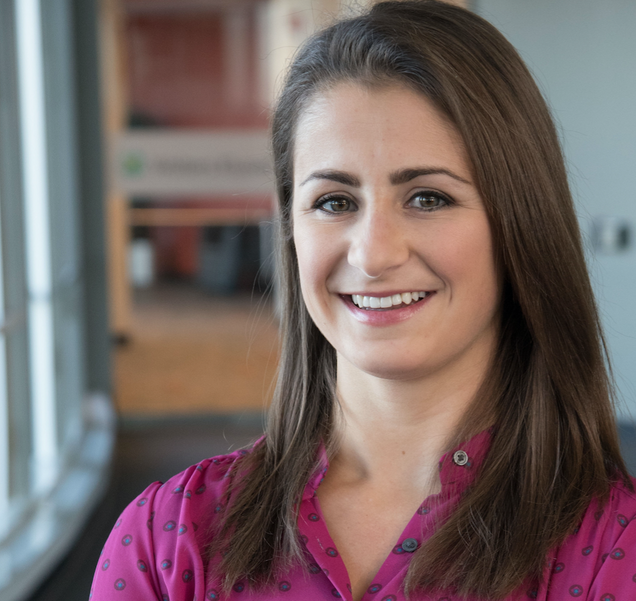
#cityplanningBU Alumna Spotlight
Lauren Masiar, MCP '16, shares her journey to becoming the Assistant Town Planner for the Town of Milton, MA

Current Position:
Lauren Masiar is currently the Assistant Town Planner for the Town of Milton, Massachusetts. Under the supervision of the Director of Planning and Community Development, she assists in the review of development proposals and site plans for conformance with bylaws, plans, and regulations of the town. She acts as a liaison between various committees, developers and the town. Lauren sits regularly in the Town Planning Board meetings, assisting the Planning Board with their evaluation of zoning amendments, permits, site plans, and other proposals. Recent projects that Lauren has been working on include drafting a Complete Streets Policy for the town and assisting the Planning Board with permitting process improvements.
Initial Interest in Environmental Design and Planning:
It all started when Lauren took an Advanced Placement Environmental Science course in high school, where she became fascinated with the concepts of climate change and human impact on the environment. This eventually lead her to the realization that she was interested in pursuing a career that would allow her to explore ways to contribute to the built environment in a conscious and sustainable manner. This is how Lauren became interested in Environmental Design and Public Policy, which ultimately lead her to the path of City Planning.
Timeline of Education/Professional Achievements:
- May 2014: Graduated from University of Massachusetts, Amherst, with a B.S. in Environmental Design with a Concentration in Urban Studies and an Undergraduate Certificate in Public Policy
- September 2014: Enrolled full-time in BU Master of City Planning program
- June 2015: Began full-time job as Transportation Management Association (TMA) Program & Policy Manager for the 128 Business Council (maintained connections with members and their employees, educating them about alternative and sustainable transportation options)
- May 2016: Graduated from BU with Master of City Planning degree and Graduate Certificate in Applied Sustainability; Recipient of the Excellence in Graduate Studies Award for the department
- Assisted in founding BU CPUA Student Association, (President February 2014-May 2016)
- July 2017: Began position as Assistant Town Planner for the Town of Milton
BUCPUA Program Experience/Takeaways:
Lauren's experience in the Boston University Master of City Planning Program provided her with an understanding of the intricate balance between economic vitality, sustainability, and social equity. Each course taken during her time in the Program pushed her to challenge herself to change her perception of the surrounding environment. The professors in the City Planning & Urban Affairs Program offer a diverse learning experience that combines academic theory with pragmatic solutions to provide students with the critical thinking skills necessary to solve real-world planning problems.
During Lauren's enrollment in the program, she chose to take advantage of the multitude of topics offered each semester. By combining required courses such as economic development, planning theory, and qualitative and quantitative research methods with elective topics ranging from planning law, urban design, impacts of climate change, geographic information systems, etc., she was able to experience the multifaceted dimensions of the planning profession. This diverse background in planning principles provided the framework necessary for Lauren to begin her career in municipal planning.
By Lauren Masiar, MCP '16, and Andrea Ciminelli
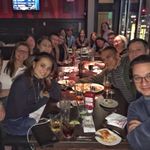
#BUCPUA Urban Planning Association’s Bright Future
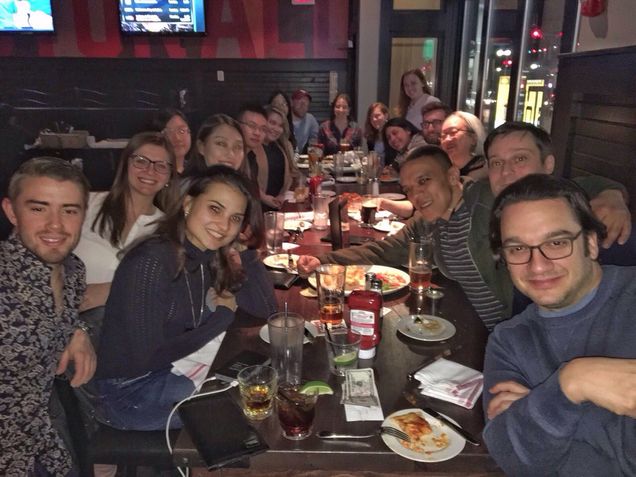
The mission of the #BUCPUA Urban Planning Association (UPA) has always been one to create opportunity for its students and faculty, to get to know each other, and to create a network of connections that both parties can benefit from. By creating a more inclusive and friendly environment, it encourages students to reach out to faculty and ask for advice on career paths and their professional future. It truly highlights the passion and enthusiasm felt by students and professors alike, which allows members of the #BUCPUA Community to take this professional and academic talk into a more casual and informal setting. Traditionally the UPA holds several different events throughout the semester – ranging from social gatherings and community service activities, as well as networking events to create a comprehensive and supportive community within the City Planning and Urban Affairs Program.

This year’s administration has done a fantastic job of engaging both faculty and students, as well as continuing to foster the spirit of community building. When talking to the current administration, many of them mentioned joining the UPA to further the resources available to the #BUCPUA Program, and also as a way to get to know their fellow peers. Luis Quintanilla, MCP '17 – the current outgoing President – mentioned how he “always knew that [he] wanted to get more involved in all the UPA's activities and the #BUCPUA Program." Luis emphasizes how he believes the value of the UPA lies in its ability to be a platform for networking: “The UPA is an opportunity for the #BUCPUA Community to get closer and learn about each other, share our interests and experiences, as well as to get more involved in the Program and with other professional associations.”

Throughout the year, the UPA carried out several different types of events, raging from the customary First Friday Social – which has always been a popular option – to field trips exploring issues of sustainable and economic development, as well as holding lectures and movie nights dealing with topics such as climate change and urban planning. When asked what is the biggest success of the current administration, Luis highlighted his interaction with people from diverse cultural backgrounds: “From city walking tours to movie nights to First Friday's, I really enjoyed learning from very interesting, smart people that perhaps otherwise we wouldn't had the opportunity to meet and have profound discussions with.”

When talking to members of the upcoming administration, many cited continuing the legacy that this year’s UPA has managed to establish. Diego Lomelli, MCP '19 – the incoming Vice President – how the main objectives lie on continuing the growth and reputation of the program. He also believes it is “important to advocate a closer coexistence of students through activities that gather students, alumni, and professors so all individuals can be aware of the latest technologies, policies, and projects” related to Urban Planning. Patricia Cahill, MCP '18 – incoming President – stressed the importance of transparency and job opportunities: “We have an extensive network, and not just in the Greater Boston area, so connecting current students to job and internship opportunities is definitely an important goal of ours.”
- Cecilia de Almeida, CAS '19